
|
 |
|
{Page 79}
Oklahoma Cooperative Fish and Wildlife Research Unit, U.S. Geological Survey, Biological Resources Division, Department of Zoology, Oklahoma State University, Stillwater, OK 74078
Department of Agricultural Economics, Oklahoma State University, Stillwater, OK 74078
Oklahoma Cooperative Fish and Wildlife Research Unit, Department of Zoology, Oklahoma State University, Stillwater, OK 74078
Department of Agricultural Economics, Oklahoma State University, Stillwater, OK 74078
We surveyed Oklahoma-licensed anglers who fished in eastern Oklahoma streams to describe their fishing preferences and socioeconomic characteristics. A screening telephone survey of 1992 Oklahoma license holders was conducted to identify individual license holders who fished in eastern Oklahoma streams and who would participate in a follow-up telephone survey. We also conducted personal interviews with anglers fishing in Baron Fork in northeastern Oklahoma and Glover River in southeastern Oklahoma. Based on 1147 completed screening surveys, an estimated 12% of Oklahoma license holders fished in and took one or more trips per year to eastern Oklahoma streams. Seventy percent of licensed anglers said they fished for black bass species, 53% fished for catfish, and less than 20% fished for other species such as temperate bass, sunfish, and trout. However, surveyed anglers who fished in Baron Fork sought black bass species more often than those who fished in Glover River. Eastern Oklahoma anglers used public areas more than private areas to access streams for fishing, and they fished from the bank or in a boat or canoe more often than by wading or in a float tube. Based on 100 completed follow-up surveys of eastern Oklahoma residents who held fishing licenses and who made trips to streams in the region in 1993, the average cost:benefit per trip ranged from $4.08:$8.31 to $12.10:$30.30, and those who fished averaged between 12.9 and 26.9 trips per year to streams. Estimated annual benefits for all trips to eastern Oklahoma streams were approximately $24 million in 1993. These findings verify the importance of eastern Oklahoma stream fishing to the economy of this region. © 2002 Oklahoma Academy of Science
| Introduction | Methods | Results | Discussion | References | Top of Page | Table of Contents | Home |
Oklahoma's streams and rivers provide a unique fishing experience for anglers. A 1996 national survey estimated that of a total 891,000 resident and nonresident anglers 16 years and older who fished in Oklahoma, most (845,000) fished in ponds, lakes, and reservoirs; however, about one-third (272, 000) spent 2,507,000 days fishing in streams and rivers of the state (1). Much of the stream fishing activity occurs in eastern Oklahoma (2) where the character of the streams and fish assemblages differ greatly from those in the central and western parts of the state (3). Past surveys of fish populations in eastern Oklahoma streams have revealed abundant sport fish populations with some geographic differences (4,5). However, little is known about the fishing and socioeconomic characteristics of stream anglers and their attitudes and opinions.
{Page 80}
Fishing in Oklahoma is a multi-million dollar industry. An estimated $491 million was spent by state residents and non-residents on fishing in Oklahoma in 1996 (1). Over half (54%) of these fishing expenditures were trip-related; the remainder were equipment and other expenditures. To understand the economic value of stream fishing in Oklahoma, information on the economic benefits of fishing trips to streams, particularly those in eastern Oklahoma, is needed (6). An understanding of the socioeconomic value along with the biological and recreational values of streams is important to managing stream fisheries resources (7,8).
The purpose of this article is to assess the socioeconomic characteristics Oklahoma-licensed anglers, their effort toward and success at, and attitudes and opinions about recreational fishing in eastern Oklahoma streams. Our findings are based on surveys conducted from 1993 to 1995 of Oklahoma fishing and hunting license holders. We discuss management implications for eastern Oklahoma stream anglers based on these findings.
| Introduction | Methods | Results | Discussion | References | Top of Page | Table of Contents | Home |
We conducted telephone surveys of fishing and hunting license holders in Oklahoma and personal interviews with people fishing in two eastern Oklahoma streams. Telephone screening and follow-up surveys were conducted in 1993 and 1994 by staff at Oklahoma State University. Personal interviews were conducted with stream anglers fishing in Baron Fork of the Illinois River, Cherokee and Adair Counties, and in the Glover River, McCurtain County, Oklahoma, in 1994 and 1995.
Telephone surveys: We conducted the screening telephone survey to identify eastern Oklahoma stream anglers from the 1992 population of Oklahoma fishing and combination fishing and hunting license holders. Information on type of license and total license sales (rounded to the nearest thousand) was provided by the Oklahoma Department of Wildlife Conservation (Table 1).
The 1992 population of license holders (n = 627,000) was stratified by license type; a random sample was independently drawn from each type. The original sample of 3000 license holders was augmented by 609 randomly selected annual resident fishing license holders from 24 counties in eastern Oklahoma to increase the number of eastern Oklahoma stream anglers (Table 1).
Telephone interviews were conducted with resident, nonresident, senior citizen, and lifetime license holders. Responses from completed surveys of all license holders were compared to those who fish in eastern Oklahoma streams. Information was obtained on license holder demographics (i.e., gender, age, education, race, income) and fishing characteristics (i.e., water bodies fished and number of fishing trips) including those in 1992. License holders fishing in eastern Oklahoma streams and small rivers were identified for the purpose of gathering data for 1993 and for participation in the Oklahoma Stream Angler Cooperator Program (Fig. 1).
The survey instrument we used was designed primarily to identify individual license holders who fished in eastern Oklahoma small rivers and streams and who would participate in a 2-y cooperator program. However, to accomplish this the survey first identified whether the license holder fished in Oklahoma in 1992. If the license holder did fish in Oklahoma in 1992, then the water types and locations they frequented were recorded. Subsequently, licensed eastern Oklahoma stream anglers who fished eastern Oklahoma streams were distinguished from all other license holders.
From the 1147 completed screening survey of 1992 Oklahoma license holders, 1066 actually fished in 1992. Of these, 172 fished in eastern Oklahoma streams and rivers and were contacted to obtain information about their fishing characteristics (i.e., water body fished, species sought, access to stream, fishing methods used, and time of fishing; Fig. 1).
The 172 license holders were contacted after the 1993 fishing year and a follow-up survey was conducted to obtain information about their fishing trips in 1993. Surveys
{Page 81}
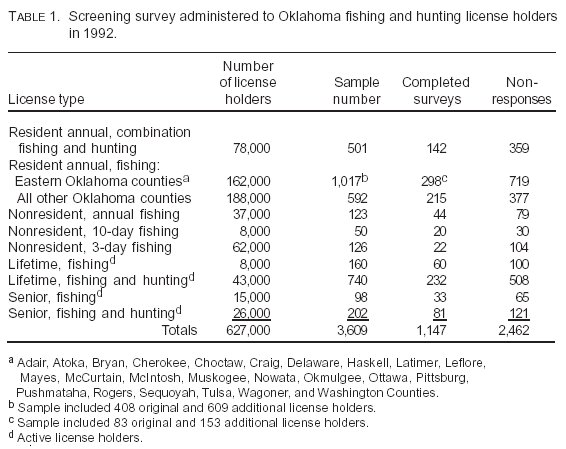
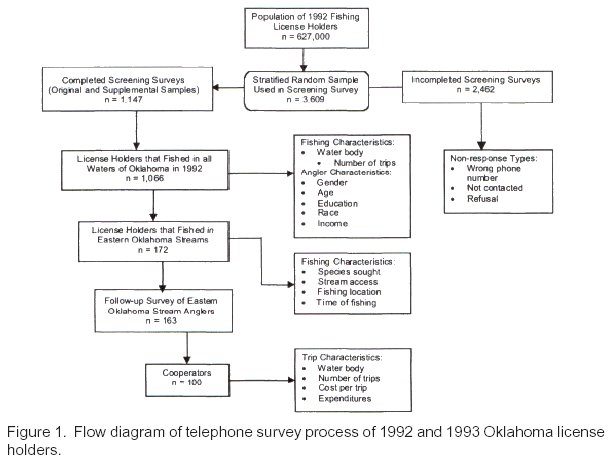
{Page 82}
were completed for 163 people, or cooperators, from this sample. Those not contacted either had moved, were deceased, had changed their telephone number, or were not contacted after five attempts. Of the 163 cooperators, we were only able to obtain complete data for 100 of them. We eliminated 63 cooperators for the following reasons: 45 license holders gave no response about purchasing a license or making fishing trips in 1993, 9 license holders had poor responses or missing information, 7 senior citizen license holders, because of their advanced age, exceeded the limit for the age factor variable in the model (6), 6 anglers did not buy a fishing license in 1993, and 1 license holder was an out-of-state resident. These 100 cooperators provided complete data on sociodemographic attributes, number of streams fished, number of fishing trips taken, one-way travel distances, and trip-related expenditures.
We used a negative binomial count data model (9) to estimate fishing trip demand for eastern Oklahoma streams. The dependent variable in the model was the number of fishing trips made by a license holder in 1993. Independent variables included travel cost to eastern Oklahoma streams, number of fishing trips to other waters (large rivers, small lakes and ponds, and large reservoirs), and sociodemographic data (gender, age, education level, and race). An estimate of cost benefits per trip was obtained by computing the consumer surplus and calculating, through integration, the area under the demand curve and above the price line. For the count data model, the estimated demand function was the probability distribution of the number of fishing trips. The expected value of this distribution yielded the trip benefit function (i.e., expected number of trips at each price). A measure of the expected benefit (consumer surplus) was obtained by integrating under this expected response minus the actual trip cost. Details of the model structure and equations are in Negash (6).
Personal Interviews: We interviewed anglers who fished in Baron Fork with a roving creel survey and anglers who fished in the Glover River with the bus-route creel survey. Creel survey methods are described in detail in Martin (10). In 1994 and 1995 combined, we conducted 71 creel surveys in Baron Fork and 78 creel surveys in the Glover River from March through September. Anglers intercepted during the creel surveys were asked to rate the importance of stream fishing to all other fishing activities and satisfaction of their fishing experience, list the bait they used to fish, fishing technique, stream fishing location, and species sought. We used Chi-square analysis to test for probability differences in angler characteristics and preferences between Baron Fork and Glover River.
| Introduction | Methods | Results | Discussion | References | Top of Page | Table of Contents | Home |
Because of small sample sizes of several types of license holders (Table 1), we aggregated survey responses for all types to compare fishing and angler characteristics. The majority of 1992 anglers fished in standing waters such as reservoirs and ponds (Table 2). The number of anglers fishing in and the number of fishing trips to large reservoirs was nearly equal to that of effort in small impoundments and ponds. Less fishing occurred in flowing waters. Although the number of anglers fishing in large rivers and small rivers and streams was similar, those fishing in smaller flowing water types took nearly twice as many fishing trips as those fishing in larger types. Of the 105,300 anglers who fished in small rivers and streams, an estimated 72,600, or 12%, of all 1992 license holders fished in eastern Oklahoma streams and rivers (2).
Demographically, 1992 anglers were mostly middle-aged, white males with a high school education. Seventy-three percent of the license holders were male, and 27% were female. Average age of the license holders was 45 y. Education completion rates were 59% for high school, 22% for college, 13% for grade school, and 6% for vocational technical school. Eighty-nine percent of the license holders were white, 7% were native American, 2% were black, and 2% were other races. Median income of the group was $37,500, and mean income was $40,978. Because a large percentage of license holders (34%) did not report their income, care should be taken when com-
{Page 83}
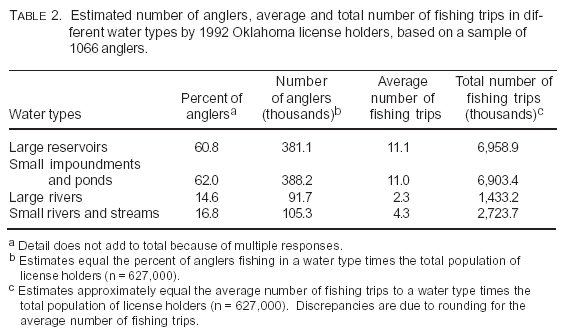
paring our income estimates with those from the population of households in Oklahoma.
Anglers fishing in eastern Oklahoma streams and rivers in 1992 sought mostly black bass (Micropterus spp.), fished from boats or along the stream bank during the morning, and gained access through public sites (Table 3). Smallmouth bass (M. dolomieui), spotted bass (M. punctulatus), and largemouth bass (M. salmoides) were fished for by nearly three-fourths and catfish by nearly one-half of all anglers. Less than one-sixth of the anglers fished for white bass (Morone chrysops) and striped bass (M. saxatilis), sunfishes (Lepomis spp.), and rainbow trout (Oncorhynchus mykiss). About three-quarters of anglers gained access to streams from public land, whereas about two-fifths accessed streams from private lands. Two-thirds of the anglers fished from boats or canoes and the stream bank, and about one-fifth waded or used float tubes. Few people fished from bridge crossings. One-half of the anglers fished in the morning, and over one-third fished in the evening, whereas less than one-fifth fished during the midday or at night.
Anglers fishing in Baron Fork in northeastern Oklahoma exhibited different attitudes and preferences than those fishing in the Glover River in southeastern Oklahoma (Table 4). In general, most anglers (>75%) in both streams, and slightly more in the Glover River, rated the importance of stream fishing compared to all other fishing activities as extremely important to above average. However, by the same proportion (ca. 75%), anglers in both streams rated their fishing that day as fair or poor. More (20%) anglers used artificial bait in Baron Fork than did anglers fishing in the Glover River, whereas anglers fishing in the Glover River used natural bait more than those fishing in Baron Fork. Nearly all anglers (>89%) in both streams used rod and reel for fishing; however, trotlines for catfishing were used more often in Glover River. Ninety percent of Baron Fork anglers and 66% of Glover River anglers fished from the bank or by wading in the stream; however, significantly more Glover River anglers fished from a boat, canoe, or wading tube. Half of the anglers fishing in Baron Fork and one-third of those fishing in the Glover River said they were fishing for black bass species, and significantly more anglers fished for sunfish and catfish in the Glover River than in Baron Fork. However, half of the anglers in both streams said they had no preference for catching any particular species.
Among the cooperators in our survey (i.e., 1993 Oklahoma license holders), 80%
{Page 84}
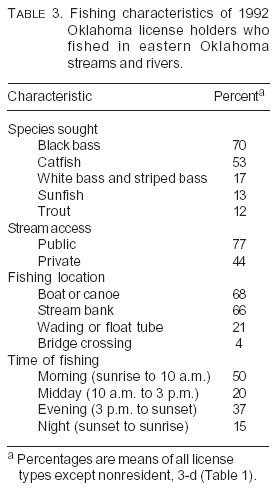
fished in eastern Oklahoma streams and 74% fished in reservoirs. About one-third (36%) fished in small impoundments and ponds, and slightly more (38%) fished in large rivers.
Estimated economic benefits were greater for resident annual than for lifetime license holders (Table 5). On average, resident annual, fishing only license holders spent less per trip ($4.08) but took more trips (26.9) than did resident annual, combined fishing and hunting license holders who spent nearly three times more per trip ($12.10) but took fewer trips (22.3). In comparison, lifetime fishing and hunting license holders spent nearly twice as much per trip ($7.96) but took about half as many trips (12.9) than lifetime fishing license holders. These four license type holders combined took over 1.6 million trips to eastern Oklahoma streams, and the estimated total economic benefit of these exceeded $24 million in 1993.
| Introduction | Methods | Results | Discussion | References | Top of Page | Table of Contents | Home |
Many Oklahomans participate in outdoor recreation. In a 1999 statewide telephone survey of Oklahomans (11), four out of five people interviewed had par-ticipated in at least one of nine outdoor recreational activities in the last 12 months, and half of all survey respondents had gone fishing. Although most fishing activity occurs in reservoirs, lakes, and ponds of the state, a substantial portion occurs in streams and rivers (1). We estimated that 197,000, or 31%, of the 627,000 1992 Oklahoma license holders fished in both small and large streams and rivers of the state. A 1991 national survey of resident and nonresident anglers estimated that 214,900, or 27%, of a total 803,700 anglers fished in streams and rivers (12). Differences between survey findings are likely a result of different sampling methods. Furthermore, an estimated 12% of 1992 Oklahoma license holders said they fished in eastern Oklahoma streams and rivers.
Stream and river fishing in Oklahoma is increasing. Between 1991 and 1996, the number of anglers fishing in streams and rivers of Oklahoma increased from 27% to 30% (1,12). Clearly, stream and river fishing in Oklahoma is important to many licensed anglers.
Oklahoma anglers contacted in our survey were demographically different than the 1991 Oklahoma population 16 years and older. Anglers in Oklahoma were predominantly white males with a high school education. We found that 73% of 1992 Oklahoma license holders were male, and 27% were female compared with the state population of 47% males and 53% females. Slightly more whites (89%), fewer blacks (2%), and more people of other races (9%, including 7% native Americans) held Oklahoma fishing and hunting licenses compared with the state population of 87% whites, 5% blacks and 8% other races. About 72% of Oklahoma license holders had a grade school or high school education, and 28% had completed higher education degrees compared with the state population of 61% and 38%, respectively. Our demo-
{Page 85}
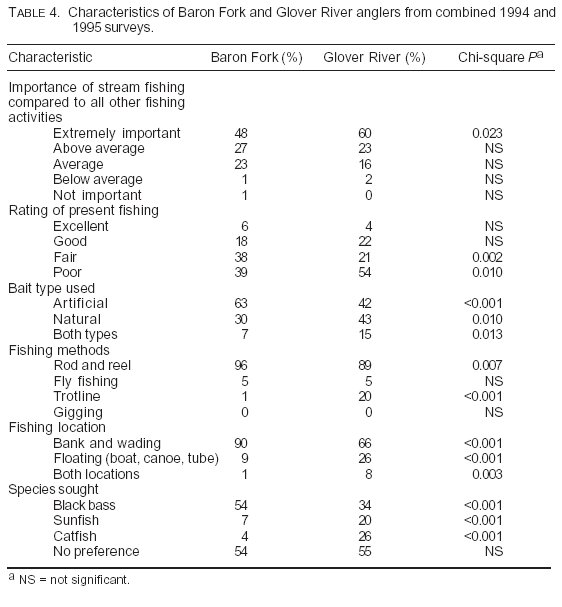
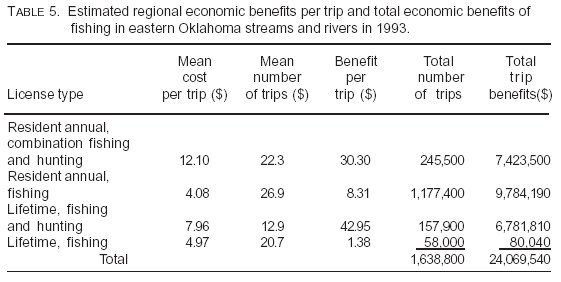
{Page 86}
graphic findings are similar to those of the 1991 national survey (12) in which 71% of anglers were male, 89% were white, but only 59% had completed high school.
Not surprisingly, the majority (>75%) of anglers we interviewed who were fishing in either Baron Fork or the Glover River rated stream fishing as either very important or extremely important compared to all other fishing activities, despite that most of them (>75%) rated their fishing as fair or poor. For those anglers, their preference for fishing in streams apparently outweighed low fishing success. Eastern Oklahoma stream and river anglers fished mainly for black bass and to a lesser extent for catfish. Surveyed anglers fishing in Baron Fork sought black bass more often than those fishing in the Glover River. Martin (10) reported that black bass catch rates by anglers fishing in Baron Fork were three times greater than those fishing in the Glover River, and Balkenbush and Fisher (5) found that black bass populations were more abundant and had greater biomass in Baron Fork than in the Glover River.
Most anglers in our statewide survey and stream surveys fished from either the stream bank or by wading. In contrast to reservoirs and large impoundments, fishing habitat in small rivers and streams is accessible either from banks or by wading, although canoes and small boats provide greater access when stream flows are suitable. However, access to streams for fishing from motorboats can be difficult because of their unidirectional flow, various obstructions (debris and dams), and shallowness. Therefore, anglers' access to streams is important. We found that most anglers gain access to streams from public sites (e.g., bridge crossings); however, bridge crossings are often widely separated or remote, making access for fishing difficult.
The economic contribution of fishing in eastern Oklahoma streams to the regional economy was previously undocumented. It has been shown that stream fisheries affect local economies. For example, findings from a 3-y study (1989-1991) of the Mountain Fork trout fishery below Broken Bow Lake in McCurtain County, Oklahoma, revealed that the majority (67%) of anglers were residents from outside the county and state, and the fishery contributed three-quarters of a million dollars annually to the local economy at the 1990 price level (13). We found that the average cost per trip and number of trips in 1993 to eastern Oklahoma streams ranged from $4.08 and 12.9 trips, respectively, by resident annual fishing license holders to $12.10 and 22.3 trips, respectively, by resident annual combination fishing and hunting license holders. Most of these expenditures took place in eastern Oklahoma where people fished, thus impacting the region. The estimated annual benefits of fishing eastern Oklahoma streams by four main groups of license holders was in excess of $24 million in 1993. Our findings demonstrate the economic importance of eastern Oklahoma stream fishing to the regional economy.
Active state-level management of eastern Oklahoma stream fisheries has increased in recent years. A 1995 survey of warm-water stream fisheries management programs in 14 southeastern states found that, although stream fisheries in Oklahoma were receiving some management, the state did not have a comprehensive stream fisheries management program (8). Since then, the Oklahoma Department of Wildlife Conservation has dedicated five people to full-time or part-time management of stream fisheries and developed a comprehensive program for managing stream fisheries, particularly in eastern Oklahoma (P. Balkenbush, pers. comm.). Management efforts are focusing on fish population assessment, stream and riparian habitat management, and stream access. Further assessments of stream angler catch and harvest, preferences and needs, and economic impact will likely aid future management efforts.
We are grateful to P. Balkenbush, G. Robel, D. Enck, D. Hickman, J. Spencer, R. Simmonds, J. Stanovick, G. Thomas, B. Warde, T. Wynn, and personnel from the
{Page 87}
Oklahoma Cooperative Fish and Wildlife Research Unit for their assistance in various phases of the study. Funding for this project was provided by the Federal Aid in Sport Fish Restoration Act under Project F-41-R of the Oklahoma Department of Wildlife Conservation. The Oklahoma Cooperative Fish and Wildlife Research Unit is a cooperative program of the U.S. Geological Survey, Biological Resources Division; Oklahoma Department of Wildlife Conservation; Oklahoma State University; and Wildlife Management Institute.
| Introduction | Methods | Results | Discussion | References | Top of Page | Table of Contents | Home |
1. US Department of Interior, Fish and Wildlife Service, US Department of Commerce, Bureau of Census. 1996 National survey of fishing, hunting, and wildlife-associated recreation, Oklahoma. US Fish and Wildlife Service: publication FHW/96-OK; 1998. Avail-able from: USDI Fish and Wildlife Service-NRTC Publication Unit, Rt 1, Box 166, Shepherdstown, WV 25443.
2. Fisher WL, Schreiner DS, Martin C, Balkenbush P, Kessler E, Negash J. Evaluation of the smallmouth bass recreational fishery in eastern Oklahoma streams. Oklahoma City (OK): Oklahoma Department of Wildlife Conservation, Federal Aid in Sport Fish Restoration Project F-41-R, Number 18; 1997.
3. Tejan EC, Fisher WL. Development of a stream fisheries management infor-mation system for Oklahoma. Oklahoma City (OK): Oklahoma Department of Wildlife Conservation, Federal Aid in Sport Fish Restoration Project F-41-R, Number 22; 2001.
4. Stark WJ, Zale AV. Status of smallmouth bass populations in eastern Oklahoma. Oklahoma City (OK): Oklahoma Department of Wildlife Conservation, Federal Aid in Sport Fish Restoration Project F-41-R, Number 14; 1991.
5. Balkenbush PE, Fisher WL. Population characteristics and management of black bass in eastern Oklahoma streams. Proc Southeast Assoc Fish Wildl Agencies 1999; 53:130-143.
6. Negash YA. Discrete choice analysis of Oklahoma fishing license holders, fishing trip demand model for eastern Oklahoma natural streams, and fishing trip demand model for fresh water bodies in Oklahoma. [PhD thesis]. Stillwater (OK): Oklahoma State University; 1999. 138 p. Available from: OSU Library.
7. Angermeier PL, Neves RJ, Nielsen LA. Assessing stream values: perspectives of aquatic resource professionals. N Am J Fish Manage 1991;11:1-10.
8. Fisher WL, Surmont AF, Martin CD. Warmwater stream and river fisheries in the southeastern United States: are we managing them in proportion to their values? Fisheries 1998;23(12):16-24.
9. Cameron AC, Trivedi PK. Econometric models based on count data: comparisons and applications of some estimators and tests. J Appl Econometrics 1986;1:29-53.
10. Martin CD. Comparisons between Ozark and Ouachita stream fisheries in eastern Oklahoma [MS thesis]. Stillwater (OK): Oklahoma State University; 1995. 97 p. Available from: OSU Library.
11. Crews A. Outdoor recreation in Oklahoma. Oklahoma City (OK): Oklahoma Department of Wildlife Conservation; 2000.
12. US Department of Interior, Fish and Wildlife Service, US Department of Commerce, Bureau of Census. 1991 National survey of fishing, hunting, and wildlife-associated recreation, Oklahoma. USDI Fish and Wildlife Service: publication; 1993. Available from: US Government Printing Office, Wash-ington, DC.
13. Schreiner DS, Lee H-S, Choi S-H, Leslie DM Jr, Harper J. Economic feasibility of a year-round trout fishery below Broken Bow dam. Oklahoma City (OK): Oklahoma Department of Wildlife Conservation, Federal Aid in Sport Fish Restoration Project F-41-R, Number 15; 1994.
Received: May 16, 2002; Accepted: September 24, 2002